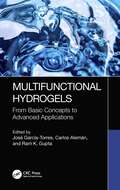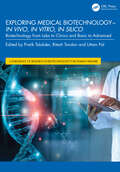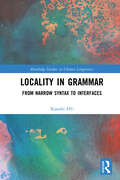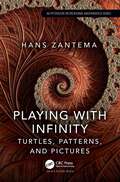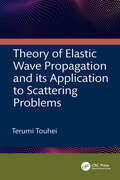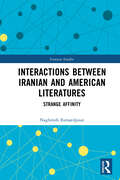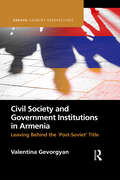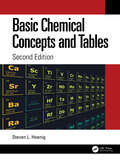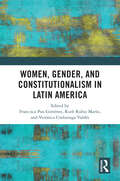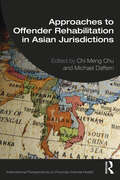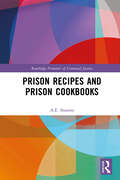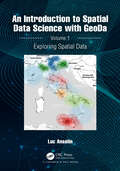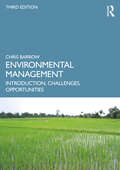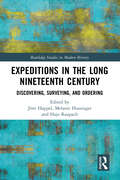- Table View
- List View
Multifunctional Hydrogels: From Basic Concepts to Advanced Applications
by José García-Torres Carlos Alemán Ram K. GuptaHydrogels are important polymer-based materials with innate fascinating properties and applications: they are three-dimensional, hydrophilic, polymeric networks that can absorb large amounts of water or aqueous fluids and are biocompatible, mechanically flexible, and soft. The incorporation of functionalities to develop smart and bioactive platforms has led to a myriad of applications. This book offers a comprehensive overview of multifunctional hydrogels, covering fundamentals, properties, and advanced applications in a progressive way. While each chapter can be read stand-alone, together they clearly describe the fundamental concepts of design, synthesis, and fabrication, as well as properties and performances of smart multifunctional hydrogels and their advanced applications in the biomedical, environmental, and robotics fields.This book:• Introduces readers to different hydrogel materials and the polymer types used to fabricate them.• Discusses conducting polymer hydrogels, nanocomposite hydrogels, and self-healing hydrogels.• Covers synthesis methodologies and fabrication techniques commonly used to confer certain structures and/or architectures.• Shows how hydrogels can be modified to incorporate new functionalities able to respond to physical and/or chemical changes.• Examines applications including bioelectronics, sensors and biosensors, tissue engineering, drug delivery, antipathogen applications, cancer theranostics, environmental applications, and soft robotics, with chapters showcasing the main advances achieved up to date in every field.Multifunctional Hydrogels: From Basic Concepts to Advanced Applications serves as a valuable resource for academic and industry researchers from interdisciplinary fields including materials science, chemistry, chemical engineering, bioengineering, physics, and pharmaceutical engineering.
Exploring Medical Biotechnology- in vivo, in vitro, in silico: Biotechnology from Labs to Clinics and Basic to Advanced (Confluence of Research in Biotechnology for Human Welfare)
This book on medical biotechnology offers a wide array of topics and cutting-edge research in the field featuring contributions from multiple authors, each specializing in their respective areas, making it highly valuable to science students and enthusiasts. The book provides comprehensive coverage on a diverse range of topics including sequence analysis, network pharmacology, drug discovery, CRISPR-Cas technology, precision medicine, neuroimaging biomarkers, therapeutics for neurodegenerative diseases, molecular pathogenesis of various diseases, plant-derived antioxidants, genetic approaches for disease diagnosis, cancer progression, immunotherapy, cancer biomarker identification, RNA Interference (RNAi) and nanotechnology in drug discovery and delivery, thus giving a holistic understanding of medical biotechnology.Each chapter delves into the latest research and developments in its respective field and offers readers insights into cutting-edge advancements in medical biotechnology. This up-to-date information will be invaluable to science students and enthusiasts who want to stay at the forefront of the field.The book adopts an interdisciplinary approach by incorporating elements of biology, genetics, computational techniques, nanotechnology and more, which enables readers to see the interconnectedness of different scientific disciplines and how they contribute to medical biotechnology.The book emphasizes practical applications, such as drug discovery, disease treatment, gene editing and targeted drug delivery. This focus on real-world applications is useful to readers interested in applying biotechnological techniques in the medical field. The book also acknowledges the serious challenges faced in the field of medical biotechnology and offers potential solutions to overcome these challenges to foster innovative thinking.As a reader, you will gain a comprehensive understanding of various aspects of medical biotechnology, equipping you with knowledge that can contribute to technological breakthroughs, advancements in medicine and the betterment of human life.
Exploring Medical Biotechnology- in vivo, in vitro, in silico: Biotechnology from Labs to Clinics and Basic to Advanced (Confluence of Research in Biotechnology for Human Welfare)
by Pratik Talukder Ritesh Tandon Uttam PalThis book on medical biotechnology offers a wide array of topics and cutting-edge research in the field featuring contributions from multiple authors, each specializing in their respective areas, making it highly valuable to science students and enthusiasts. The book provides comprehensive coverage on a diverse range of topics including sequence analysis, network pharmacology, drug discovery, CRISPR-Cas technology, precision medicine, neuroimaging biomarkers, therapeutics for neurodegenerative diseases, molecular pathogenesis of various diseases, plant-derived antioxidants, genetic approaches for disease diagnosis, cancer progression, immunotherapy, cancer biomarker identification, RNA Interference (RNAi) and nanotechnology in drug discovery and delivery, thus giving a holistic understanding of medical biotechnology.Each chapter delves into the latest research and developments in its respective field and offers readers insights into cutting-edge advancements in medical biotechnology. This up-to-date information will be invaluable to science students and enthusiasts who want to stay at the forefront of the field.The book adopts an interdisciplinary approach by incorporating elements of biology, genetics, computational techniques, nanotechnology and more, which enables readers to see the interconnectedness of different scientific disciplines and how they contribute to medical biotechnology.The book emphasizes practical applications, such as drug discovery, disease treatment, gene editing and targeted drug delivery. This focus on real-world applications is useful to readers interested in applying biotechnological techniques in the medical field. The book also acknowledges the serious challenges faced in the field of medical biotechnology and offers potential solutions to overcome these challenges to foster innovative thinking.As a reader, you will gain a comprehensive understanding of various aspects of medical biotechnology, equipping you with knowledge that can contribute to technological breakthroughs, advancements in medicine and the betterment of human life.
Locality in Grammar: From Narrow Syntax to Interfaces (Routledge Studies in Chinese Linguistics)
by Xiaoshi HuLocality in Grammar: From Narrow Syntax to Interfaces investigates the operation of locality conditions in syntax and semantics from a cross-linguistic perspective.It is claimed that there are two different types of locality conditions. One is the Generalized Minimality Condition (GMC), and the other is the Phase Impenetrability Condition (PIC). This book demonstrates that these locality conditions play different roles in different computational components of human language, and, therefore, cannot be unified as one constraint as proposed in the literature.The main idea of the book is that the two different locality conditions are sensitive to the difference between syntactic derivation and semantic interpretation and that of overt and covert syntactic derivations. Further investigation shows a more fine-grained distinction must be made between syntactic computations. It is true that GMC does not constrain overt syntactic derivations and PIC does not play a role in semantic interpretations; however, they both regulate covert syntactic computations.This book will inform postgraduate students and scholars in the field of linguistics.
Locality in Grammar: From Narrow Syntax to Interfaces (Routledge Studies in Chinese Linguistics)
by Xiaoshi HuLocality in Grammar: From Narrow Syntax to Interfaces investigates the operation of locality conditions in syntax and semantics from a cross-linguistic perspective.It is claimed that there are two different types of locality conditions. One is the Generalized Minimality Condition (GMC), and the other is the Phase Impenetrability Condition (PIC). This book demonstrates that these locality conditions play different roles in different computational components of human language, and, therefore, cannot be unified as one constraint as proposed in the literature.The main idea of the book is that the two different locality conditions are sensitive to the difference between syntactic derivation and semantic interpretation and that of overt and covert syntactic derivations. Further investigation shows a more fine-grained distinction must be made between syntactic computations. It is true that GMC does not constrain overt syntactic derivations and PIC does not play a role in semantic interpretations; however, they both regulate covert syntactic computations.This book will inform postgraduate students and scholars in the field of linguistics.
Playing with Infinity: Turtles, Patterns, and Pictures (AK Peters/CRC Recreational Mathematics Series)
by Hans ZantemaThis is a book about infinity - specifically the infinity of numbers and sequences. Amazing properties arise, for instance, some kinds of infinity are argued to be greater than others. Along the way the author will demonstrate how infinity can be made to create beautiful ‘art’, guided by the development of underlying mathematics. This book will provide a fascinating read for anyone interested in number theory, infinity, math art, and/or generative art, and could be used a valuable supplement to any course on these topics.Features: Beautiful examples of generative art Accessible to anyone with a reasonable high school level of mathematics Full of challenges and puzzles to engage readers
Playing with Infinity: Turtles, Patterns, and Pictures (AK Peters/CRC Recreational Mathematics Series)
by Hans ZantemaThis is a book about infinity - specifically the infinity of numbers and sequences. Amazing properties arise, for instance, some kinds of infinity are argued to be greater than others. Along the way the author will demonstrate how infinity can be made to create beautiful ‘art’, guided by the development of underlying mathematics. This book will provide a fascinating read for anyone interested in number theory, infinity, math art, and/or generative art, and could be used a valuable supplement to any course on these topics.Features: Beautiful examples of generative art Accessible to anyone with a reasonable high school level of mathematics Full of challenges and puzzles to engage readers
Theory of Elastic Wave Propagation and its Application to Scattering Problems
by Terumi TouheiElastic wave propagation applies to a wide variety of fields, including seismology, non-destructive testing, energy resource exploration, and site characterization. New applications for elastic waves are still being discovered. Theory of Elastic Wave Propagation and its Application to Scattering Problems starts from the standpoint of continuum mechanics, explaining stress and strain tensors in terms of mathematics and physics, and showing the derivation of equations for elastic wave motions, to give readers a stronger foundation. It emphasizes the importance of Green’s function for applications of the elastic wave equation to practical engineering problems and covers elastic wave propagation in a half-space, in addition to the spectral representation of Green’s function. Finally, the MUSIC algorithm is used to address inverse scattering problems. Offers comprehensive coverage of fundamental concepts through to contemporary applications of elastic wave propagation Bridges the gap between theoretical principles and practical engineering solutions The book’s website provides the author’s software for analyzing elastic wave propagations, along with detailed answers to the problems presented, to suit graduate students across engineering and applied mathematics.
Theory of Elastic Wave Propagation and its Application to Scattering Problems
by Terumi TouheiElastic wave propagation applies to a wide variety of fields, including seismology, non-destructive testing, energy resource exploration, and site characterization. New applications for elastic waves are still being discovered. Theory of Elastic Wave Propagation and its Application to Scattering Problems starts from the standpoint of continuum mechanics, explaining stress and strain tensors in terms of mathematics and physics, and showing the derivation of equations for elastic wave motions, to give readers a stronger foundation. It emphasizes the importance of Green’s function for applications of the elastic wave equation to practical engineering problems and covers elastic wave propagation in a half-space, in addition to the spectral representation of Green’s function. Finally, the MUSIC algorithm is used to address inverse scattering problems. Offers comprehensive coverage of fundamental concepts through to contemporary applications of elastic wave propagation Bridges the gap between theoretical principles and practical engineering solutions The book’s website provides the author’s software for analyzing elastic wave propagations, along with detailed answers to the problems presented, to suit graduate students across engineering and applied mathematics.
Interactions Between Iranian and American Literatures: Strange Affinity (Iranian Studies)
by Naghmeh EsmaeilpourIntroducing "narrative mobility" as a new approach in comparative studies of Iran and the US, this book reinterprets the politics and aesthetics of relations between the nations through an analysis of Iranian and American authors.The book focuses specifically on three authors—Simin Daneshvar, Shahriar Mandanipour, and Don DeLillo—who each employ narrative mobility to rethink intercultural negotiation, addressing parallel issues in America and Iran from different, but complementary, perspectives. The book analyzes the employment of parallel narrational techniques, presenting physically and virtually mobile characters who embody their respective countries as they move from one culture to another. The strange affinity between Iran and the US is ultimately revealed by viewing literary works as a "contact zone" through which the complicated relations and shared history of the two nations can be renegotiated. On a more theoretical level, the book reflects on the role of literature—in particular the novel as a transnational medium—as a bridge between nations in a period of globalization.With its focus on cross-cultural connections, the book will be of interest to anyone studying or researching comparative literature, US–Iran relations, and cultural studies generally.
Interactions Between Iranian and American Literatures: Strange Affinity (Iranian Studies)
by Naghmeh EsmaeilpourIntroducing "narrative mobility" as a new approach in comparative studies of Iran and the US, this book reinterprets the politics and aesthetics of relations between the nations through an analysis of Iranian and American authors.The book focuses specifically on three authors—Simin Daneshvar, Shahriar Mandanipour, and Don DeLillo—who each employ narrative mobility to rethink intercultural negotiation, addressing parallel issues in America and Iran from different, but complementary, perspectives. The book analyzes the employment of parallel narrational techniques, presenting physically and virtually mobile characters who embody their respective countries as they move from one culture to another. The strange affinity between Iran and the US is ultimately revealed by viewing literary works as a "contact zone" through which the complicated relations and shared history of the two nations can be renegotiated. On a more theoretical level, the book reflects on the role of literature—in particular the novel as a transnational medium—as a bridge between nations in a period of globalization.With its focus on cross-cultural connections, the book will be of interest to anyone studying or researching comparative literature, US–Iran relations, and cultural studies generally.
Civil Society and Government Institutions in Armenia: Leaving Behind the `Post-Soviet’ Title (Europa Country Perspectives)
by Valentina GevorgyanThe book provides an understanding of the three decades of Armenia’s young history – from the perspective of relations between civil society and government institutions. It explores the intricate dynamics between the two entities: by explaining the patterns of relations since 1991 to present. The book offers a comprehensive exploration for understanding the state-society relations, and also delves into the historical backdrop of the region. Drawing on the latest data, the author examines real-world practices exemplifying relational variations and the opportunity structures for Armenia to progress by means of its civil society.
Civil Society and Government Institutions in Armenia: Leaving Behind the `Post-Soviet’ Title (Europa Country Perspectives)
by Valentina GevorgyanThe book provides an understanding of the three decades of Armenia’s young history – from the perspective of relations between civil society and government institutions. It explores the intricate dynamics between the two entities: by explaining the patterns of relations since 1991 to present. The book offers a comprehensive exploration for understanding the state-society relations, and also delves into the historical backdrop of the region. Drawing on the latest data, the author examines real-world practices exemplifying relational variations and the opportunity structures for Armenia to progress by means of its civil society.
Basic Chemical Concepts and Tables
by Steven L. HoenigFully revised and expanded, the second edition of Basic Chemical Concepts and Tables is written as a quick reference to the many different concepts and ideas encountered in chemistry. The volume presents important subjects in a concise format that makes it a practical resource for any reader.Subjects include general chemistry, inorganic chemistry, organic chemistry, and spectral analysis. The new edition includes updated tables that are useful for the interpretation of ultraviolet-visible (UV-Vis), infrared (IR), nuclear magnetic resonance (NMR) and mass spectroscopy (MS) spectra, and expanded sections devoted to the concept of isomers and polymer structures and includes a new chapter on nuclear chemistry. Separate chapters offer physical constants and unit measurements commonly encountered and mathematical concepts needed when reviewing or working with basic chemistry concepts.Key features:• Provides chemical information in a concise format, fully illustrated with many graphs and charts, ideal for course review.• Supplements traditional exam review books, serving undergraduate or graduate students.• Provides professionals looking for a quick introduction to a topic with a comprehensive ready reference.Graduate and undergraduate chemistry students, professionals or instructors looking to refresh their understanding of a chemistry topic will find this reference indispensable in their daily work.
Basic Chemical Concepts and Tables
by Steven L. HoenigFully revised and expanded, the second edition of Basic Chemical Concepts and Tables is written as a quick reference to the many different concepts and ideas encountered in chemistry. The volume presents important subjects in a concise format that makes it a practical resource for any reader.Subjects include general chemistry, inorganic chemistry, organic chemistry, and spectral analysis. The new edition includes updated tables that are useful for the interpretation of ultraviolet-visible (UV-Vis), infrared (IR), nuclear magnetic resonance (NMR) and mass spectroscopy (MS) spectra, and expanded sections devoted to the concept of isomers and polymer structures and includes a new chapter on nuclear chemistry. Separate chapters offer physical constants and unit measurements commonly encountered and mathematical concepts needed when reviewing or working with basic chemistry concepts.Key features:• Provides chemical information in a concise format, fully illustrated with many graphs and charts, ideal for course review.• Supplements traditional exam review books, serving undergraduate or graduate students.• Provides professionals looking for a quick introduction to a topic with a comprehensive ready reference.Graduate and undergraduate chemistry students, professionals or instructors looking to refresh their understanding of a chemistry topic will find this reference indispensable in their daily work.
Women, Gender, and Constitutionalism in Latin America
This book discusses to what extent and how constitutional design and practice in Latin America have helped in combatting the subordination of women and LGBTQIA+ people. Covering 11 jurisdictions, the chapters identify the main elements of the constitutional gender order and survey jurisprudential and legislative developments in different areas, incorporating contextual analysis and references to history, political dynamics, social movements, feminist struggles, normative efficacy, and policy.In the context of a constitutionalism that has been celebrated as particularly innovative and socially engaged, the book assesses constitutional performance in the quest to supersede the separate gendered spheres tradition and the subordination of women and sexual minorities to heteronormative hegemony. It fills an important gap in the field of gender and constitutionalism, which has paid very little attention to Latin America compared to the Anglo-American legal world and continental Europe. It identifies regional trends, but also variables which account for the diversity of approaches in various jurisdictions.The book provides much-needed insight into matters that are relevant for legal and socio-legal scholars, an ever-growing number of social actors and movements, and all those interested in comparative constitutionalism and in the intersections between law and gender.
Women, Gender, and Constitutionalism in Latin America
by Francisca Pou Giménez, Ruth Rubio Marín, and Verónica Undurraga ValdésThis book discusses to what extent and how constitutional design and practice in Latin America have helped in combatting the subordination of women and LGBTQIA+ people. Covering 11 jurisdictions, the chapters identify the main elements of the constitutional gender order and survey jurisprudential and legislative developments in different areas, incorporating contextual analysis and references to history, political dynamics, social movements, feminist struggles, normative efficacy, and policy.In the context of a constitutionalism that has been celebrated as particularly innovative and socially engaged, the book assesses constitutional performance in the quest to supersede the separate gendered spheres tradition and the subordination of women and sexual minorities to heteronormative hegemony. It fills an important gap in the field of gender and constitutionalism, which has paid very little attention to Latin America compared to the Anglo-American legal world and continental Europe. It identifies regional trends, but also variables which account for the diversity of approaches in various jurisdictions.The book provides much-needed insight into matters that are relevant for legal and socio-legal scholars, an ever-growing number of social actors and movements, and all those interested in comparative constitutionalism and in the intersections between law and gender.
Approaches to Offender Rehabilitation in Asian Jurisdictions (International Perspectives on Forensic Mental Health)
by Chi Meng Chu Michael DaffernThis book aims to understand how Asian jurisdictions conceptualise rehabilitation within both the correctional and forensic mental health sectors.Little has been written about rehabilitation practices for people in criminal justice and forensic mental health services in Asia. Although there is some recognition of the need to develop and/or adjust rehabilitation practices for non-white/non-western peoples in Western jurisdictions, the extent to which Western-derived practices have been considered, adjusted, or adopted in Asian countries is not well known. This book includes contributions from an international team who explore the ways in which history, culture, religion, and resources impact how rehabilitation is conceptualised and offered in multiple Asian countries. It aims to provide an understanding of the relative merits of contemporary Western practices across different Asian countries and consider how these practices have been adopted and adapted within correctional and forensic mental health sectors.This book is essential for administrators who are developing rehabilitation strategies and for practitioners working with people who have a history of offending behaviour.
Prison Recipes and Prison Cookbooks (Routledge Frontiers of Criminal Justice)
by A.E. StearnsPrison Recipes and Prison Cookbooks provides an innovative exploration of U.S.-based prison cookbooks using a narrative criminological approach.The book relies on the voices of prison cookbook authors to argue that cookbook narratives are a form of communication with the free world. Further, the book undertakes thematic analyses of prison cookery and narratives to illuminate the intersections of incarceration with abolition, gender, literacy, and dehumanization. The reader is introduced to the power and symbolism of cell made food, as well as the agency and resourcefulness of those who cook, bake, and write about food behind bars.Prison Recipes and Prison Cookbooks is of interest to instructors of courses covering the sociology of food, criminology, human geography, and anthropology. The book is also appropriate for prison and probation services, health organizations, and anyone engaged in the criminal-legal system, abolition movements, or social reform.
Prison Recipes and Prison Cookbooks (Routledge Frontiers of Criminal Justice)
by A.E. StearnsPrison Recipes and Prison Cookbooks provides an innovative exploration of U.S.-based prison cookbooks using a narrative criminological approach.The book relies on the voices of prison cookbook authors to argue that cookbook narratives are a form of communication with the free world. Further, the book undertakes thematic analyses of prison cookery and narratives to illuminate the intersections of incarceration with abolition, gender, literacy, and dehumanization. The reader is introduced to the power and symbolism of cell made food, as well as the agency and resourcefulness of those who cook, bake, and write about food behind bars.Prison Recipes and Prison Cookbooks is of interest to instructors of courses covering the sociology of food, criminology, human geography, and anthropology. The book is also appropriate for prison and probation services, health organizations, and anyone engaged in the criminal-legal system, abolition movements, or social reform.
An Introduction to Spatial Data Science with GeoDa: Volume 1: Exploring Spatial Data
by Luc AnselinThis book is the first in a two-volume series that introduces the field of spatial data science. It offers an accessible overview of the methodology of exploratory spatial data analysis. It also constitutes the definitive user’s guide for the widely adopted GeoDa open-source software for spatial analysis. Leveraging a large number of real-world empirical illustrations, readers will gain an understanding of the main concepts and techniques, using dynamic graphics for thematic mapping, statistical graphing, and, most centrally, the analysis of spatial autocorrelation. Key to this analysis is the concept of local indicators of spatial association, pioneered by the author and recently extended to the analysis of multivariate data.The focus of the book is on intuitive methods to discover interesting patterns in spatial data. It offers a progression from basic data manipulation through description and exploration to the identification of clusters and outliers by means of local spatial autocorrelation analysis. A distinctive approach is to spatialize intrinsically non-spatial methods by means of linking and brushing with a range of map representations, including several that are unique to the GeoDa software. The book also represents the most in-depth treatment of local spatial autocorrelation and its visualization and interpretation by means of GeoDa.The book is intended for readers interested in going beyond simple mapping of geographical data to gain insight into interesting patterns. Some basic familiarity with statistical concepts is assumed, but no previous knowledge of GIS or mapping is required.Key Features:• Includes spatial perspectives on cluster analysis• Focuses on exploring spatial data• Supplemented by extensive support with sample data sets and examples on the GeoDaCenter websiteThis book is both useful as a reference for the software and as a text for students and researchers of spatial data science.Luc Anselin is the Founding Director of the Center for Spatial Data Science at the University of Chicago, where he is also the Stein-Freiler Distinguished Service Professor of Sociology and the College, as well as a member of the Committee on Data Science. He is the creator of the GeoDa software and an active contributor to the PySAL Python open-source software library for spatial analysis. He has written widely on topics dealing with the methodology of spatial data analysis, including his classic 1988 text on Spatial Econometrics. His work has been recognized by many awards, such as his election to the U.S. National Academy of Science and the American Academy of Arts and Science.
An Introduction to Spatial Data Science with GeoDa: Volume 1: Exploring Spatial Data
by Luc AnselinThis book is the first in a two-volume series that introduces the field of spatial data science. It offers an accessible overview of the methodology of exploratory spatial data analysis. It also constitutes the definitive user’s guide for the widely adopted GeoDa open-source software for spatial analysis. Leveraging a large number of real-world empirical illustrations, readers will gain an understanding of the main concepts and techniques, using dynamic graphics for thematic mapping, statistical graphing, and, most centrally, the analysis of spatial autocorrelation. Key to this analysis is the concept of local indicators of spatial association, pioneered by the author and recently extended to the analysis of multivariate data.The focus of the book is on intuitive methods to discover interesting patterns in spatial data. It offers a progression from basic data manipulation through description and exploration to the identification of clusters and outliers by means of local spatial autocorrelation analysis. A distinctive approach is to spatialize intrinsically non-spatial methods by means of linking and brushing with a range of map representations, including several that are unique to the GeoDa software. The book also represents the most in-depth treatment of local spatial autocorrelation and its visualization and interpretation by means of GeoDa.The book is intended for readers interested in going beyond simple mapping of geographical data to gain insight into interesting patterns. Some basic familiarity with statistical concepts is assumed, but no previous knowledge of GIS or mapping is required.Key Features:• Includes spatial perspectives on cluster analysis• Focuses on exploring spatial data• Supplemented by extensive support with sample data sets and examples on the GeoDaCenter websiteThis book is both useful as a reference for the software and as a text for students and researchers of spatial data science.Luc Anselin is the Founding Director of the Center for Spatial Data Science at the University of Chicago, where he is also the Stein-Freiler Distinguished Service Professor of Sociology and the College, as well as a member of the Committee on Data Science. He is the creator of the GeoDa software and an active contributor to the PySAL Python open-source software library for spatial analysis. He has written widely on topics dealing with the methodology of spatial data analysis, including his classic 1988 text on Spatial Econometrics. His work has been recognized by many awards, such as his election to the U.S. National Academy of Science and the American Academy of Arts and Science.
Environmental Management: Introduction, Challenges, Opportunities
by Chris BarrowThis comprehensively updated third edition explores the nature and role of environmental management and offers an introduction to this rapidly expanding and changing field. It focuses on challenges and opportunities, and core concepts including sustainable development. The book is divided into five parts: Part I (Introduction to Environmental Management): four introductory chapters cover the justification for environmental management, its theory, scope, goals and scientific background Part II (Practice): explores environmental management in economics, law and business and environmental management’s relation with environmentalism, international agreements and monitoring Part III (Global Challenges and Opportunities): examines resources, challenges and opportunities, both natural and human-caused or human-aggravated Part IV (Responses to Global Challenges and Opportunities): explores mitigation, vulnerability, resilience, adaptation and how technology, social change and politics affect responses to challenges Part V (The Future): the final chapter considers the way ahead for environmental management in the future. With its well-structured coverage, effective illustrations and foundation for further, more-focused interest, this book is easily accessible to all.It is an essential reference for undergraduates and postgraduates studying environmental management and sustainability, and an important resource for many students on courses including environmental science, environmental studies and human geography.
Environmental Management: Introduction, Challenges, Opportunities (Routledge Perspectives On Development Ser.)
by Chris BarrowThis comprehensively updated third edition explores the nature and role of environmental management and offers an introduction to this rapidly expanding and changing field. It focuses on challenges and opportunities, and core concepts including sustainable development. The book is divided into five parts: Part I (Introduction to Environmental Management): four introductory chapters cover the justification for environmental management, its theory, scope, goals and scientific background Part II (Practice): explores environmental management in economics, law and business and environmental management’s relation with environmentalism, international agreements and monitoring Part III (Global Challenges and Opportunities): examines resources, challenges and opportunities, both natural and human-caused or human-aggravated Part IV (Responses to Global Challenges and Opportunities): explores mitigation, vulnerability, resilience, adaptation and how technology, social change and politics affect responses to challenges Part V (The Future): the final chapter considers the way ahead for environmental management in the future. With its well-structured coverage, effective illustrations and foundation for further, more-focused interest, this book is easily accessible to all.It is an essential reference for undergraduates and postgraduates studying environmental management and sustainability, and an important resource for many students on courses including environmental science, environmental studies and human geography.
Expeditions in the Long Nineteenth Century: Discovering, Surveying, and Ordering (Routledge Studies in Modern History)
This book examines the processes of scientific, cultural, political, technical, colonial and violent appropriation during the 19th century. The 19th century was the century of world travel. The earth was explored, surveyed, described, illustrated, and categorized. Travelogues became world bestsellers. Modern technology accompanied the travelers and adventurers: clocks, a postal and telegraph system, surveying equipment, and cameras. The world grew together faster and faster. Previously unknown places became better known: the highest peaks, the coldest spots, the hottest deserts, and the most remote cities. Knowledge about the white spots of the earth was systematically collected. Those who made a name for themselves in the 19th century are still read today. Alexander von Humboldt or Charles Darwin made the epoch a scientific heyday. Ida Pfeiffer or Isabelle Bird (Bishop) traveled to distant continents and took their readers at home on insightful journeys. Hermann Vámbéry or Sir Richard Burton got to know the most remote languages and regions. There are countless travel reports about a fascinating century, which, with surveying and exploration, also brought colonial conquest and exploitation into the world. In ten individual studies, the authors explore travelers from all over the world and analyze their successes. The unifying element of all the studies is the experience of distance and its communication by means of travelogues to the armchair travelers who have stayed at home.This volume will be of value to students and scholars both interested in modern history, social and cultural history, and the history of science and technology.
